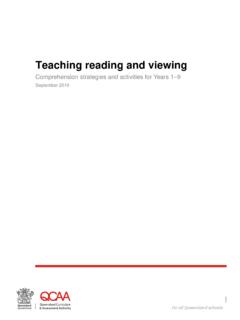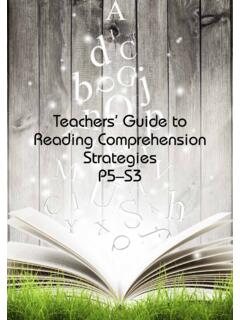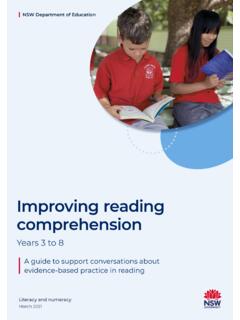Transcription of Degrees of Reading Power - Questar Assessment
1 Degrees of Reading Power Report Interpretation GuideMore detailed information about the DRP program, including technical specifications, can be found in the publication The DRP Handbook, available from Questar Assessment of Reading Power , DRP, and Success By Your Standards are registered trademarks of Questar Assessment 2016 by Questar Assessment Inc. No part of this publication may be reproduced and/or transmitted by any means without the written permission of Questar Assessment , Inc. All rights reserved. Printed in the USA. | 1 DRP TEST SCORESDRP test scores are reported on a scale of text complexity. A percent, or level, of comprehension is associated with each DRP test score. As the percent of comprehension increases, the complexity or difficulty of the materials that a student can understand with that level of comprehension must decrease. This is shown in the numbers below under the heading DRP Test FormRaw Score (No.)
2 Of correct items)DRP Scores at various Percents or Levels of ComprehensionInstructionalIndependent50% 70%75%80%90%Juanita Doe6A356860575446 All DRP test scores must be related to a specific percent, or level of comprehension . In other words, Juanita can read materials as difficult as 68 DRP units, but with only 50% comprehension . However, for materials as easy as 46 DRP units, Juanita can understand 90% of the text. This is often called the Independent level of comprehension , because the student is not likely to need instructional support to comprehend such text on her DRP scores tell you what your students can read. You can use your DRP test results to: Set expectations and goals Monitor student progress in Reading Guide classroom instructionUSE DRP SCORES TO SET EXPECTATIONS AND GOALSOne way to look at setting expectations and goals is to think about what students are expected to read at each educational level.
3 For example, students who plan to drive should be able to read their state s driver s license manual (avg. DRP=64). The Common Core State Standards (CCSS) create a staircase of increasing text complexity so that students are expected to develop their skills and apply them to more and more complex texts. The College and Career Readiness (CCR) Anchor Standard 10 for Reading states a major college and career readiness goal: Read and comprehend complex literary and informational texts independently and It is similarly worded as Standard 10 in each grade-level set of the CCSS in Reading . The standards leading up to Standard 10 emphasize the close, careful, and critical thinking/ Reading actions that lead to comprehension of complex texts, even though they do not specify the underlying skills and strategies that must be applied in order to achieve the independent comprehension goal.
4 See correspondence of DRP text complexity values and CCSS Grade Bands in the DRP Staircase of Text Complexity illustrated on page 2. 2 |DRP Staircase of Text ComplexityGrades K 1 Grades K 1 Below 44 DRPG rades 2 3 Grades 2 342 54 DRPG rades 4 5 Grades 4 552 60 DRPG rades 6 8 Grades 6 857 67 DRPG rades 9 10 Grades 11 CCRC ollege & Career ReadinessGrades 9 1062 72 DRPG rades 11 1267 74 DRPG raduate School, College, and WorkplaceAbove 70 DRP(College & Career Readiness)DRP ScaleCCSS Grade Bands80706050403020 DRP Reading goals based on CCSS end-of-year text complexity standards have been set at each grade level. With multiple administrations of DRP tests during the school year, you can monitor students progress toward those goals. End-of-Year Text Complexity Standards by Grade in DRP Units (based on CCSS Grade Bands)42 54 DRP52 60 DRP57 67 DRP62 72 DRP67 74 DRPC ollege & Career Readiness (CCR) = 70 DRP @ P=.
5 90 Gr 2Gr 3Gr 4Gr 5Gr 6Gr 7Gr 8Gr 9Gr 10Gr 11Gr 1242 4948 5452 5755 6057 6260 6462 6762 6964 7267 7267 74 Minimum Level of comprehension for the Text Complexity Expectations above to be considered On Grade at end of school year: Gr 2 Gr 3 Gr 4 Gr 5 Gr 6 Gr 7 Gr 8 Gr 9 Gr 10 Gr 11 Gr 12 CCRP=.70P=.75P=.80P=.90 | 3 USE DRP SCORES TO MONITOR STUDENT PROGRESS IN READINGAll DRP test scores are reported on the same equal-interval scale. A DRP score increase of 5 points in grade 4 is equal to an increase of 5 points in grade 10. Thus, it is possible to measure individual growth in Reading and compare the level of growth among individuals or groups.*Although there are enormous differences in ability to read and comprehend text among students, classes, and schools, some generalizations can be made: Students in grades 2 and 3 typically show rapid growth within a school year as much as 10 DRP units.
6 Growth from grades 4 through 8 averages about 4 DRP units per year. In high school, growth from fall to spring is smaller about 1-2 DRP at all grade levels can monitor student progress in Reading over time by administering DRP tests as pretests and posttests. And because DRP test scores tell you what a student can read, progress can be measured in those terms as describing student performance by CCSS comprehension clusters include Individual Performance Chart Alphabetical Roster CCSS Diagnostic SummaryUSE DRP SCORES TO GUIDE CLASSROOM INSTRUCTIONThe DRP scores shown on your score reports reflect the difficulty level of books your students should be able to read and comprehend. This information can be useful both in selecting appropriate materials for your students and in planning your classroom test scores can be used in two ways:1. First, the teacher can start with the DRP difficulty or text complexity of assigned instructional materials in DRP units, and identify those students who can read the materials with a high level of comprehension , as well as those who are able to read the materials with only a low level of Second, the teacher can start with the students DRP test scores and use DRP BookLink to find books that match the needed level of comprehension for assignments.
7 The online DRP Analyzer tool can also be used to determine the text complexity of locally developed texts or brief articles being used for class instruction.*When measuring growth, it is important to use DRP scores at the same level of comprehension , for example, compare Independent Level (P=.90) pretest and posttest scores. 4 |MANAGE CLASSROOM INSTRUCTIONU sing students DRP scores and published DRP readability information, teachers can Determine which books are more appropriate for classroom instruction and which for independent Reading Determine which students will need assistance with their Reading assignments, and which students can be expected to do more challenging work Build classroom Reading collections that correspond in difficulty to the Reading abilities of students in their class Use DRP BookLink software to generate summer Reading lists. Books in the school library can also be sorted and/or coded according to their difficulty level, helping students find books that are appropriate in relation to their Reading abilityAdditionally, the passage sets on the DRP Tests contain a balance of three types of test items that correspond to the three clusters of the CCR Anchor Standards for Reading and the CCSS Reading Standards for Informational Text: Key Ideas and Details (CCR Anchor Standards 1 3 for Reading ) Craft and Structure (CCR Anchor Standards 4 6 for Reading ) Integration of Knowledge and Ideas (CCR Anchor Standards 7 9 for Reading )For each of the three clusters, a CCSS diagnostic score (Teach, Practice, or Apply) is provided for each student.
8 These will assist teachers in differentiating instruction and in grouping students with similar needs for intervention, reinforcement, and enrichment COMPLEXITY, Reading comprehension ABILITY, AND EFFECTIVE LEARNINGS tudents need to be able to comprehend their books and assigned texts if effective learning is to take place. But how much comprehension is desirable, and under what conditions? If materials are too easy, then students may become disengaged; if they are too hard, students often become frustrated. In either case, effective learning is amount of comprehension necessary for effective learning is influenced by many factors. Student factors such as interest, motivation, study habits, and background knowledge are known to influence effective learning. Similarly, the quality of the textbook, in the sense of being considerate for the intended reader, is known to influence effective learning.
9 However, three teacher-controlled factors are often the most important influences. Stated as questions, these factors are:1. What is the purpose of Reading ? If the assigned Reading is for the purpose of acquiring or applying content knowledge, then the student must be able to read the material with a higher level of comprehension . If the purpose for Reading is to improve the student s Reading ability, then the material must provide some challenge for the student. In other words, the teacher would want to use materials that are more complex, relative to the student s Reading ability. The students can be taught strategies that stretch their Reading comprehension abilities. | 52. What is the nature of the Reading tasks? If the Reading involves lower order cognition such as minimally inferential Reading for key ideas and details, then the materials could be more complex relative to the student s Reading ability.
10 On the other hand, if the assigned task involves higher order cognition such as critical or evaluative Reading , then the student must be able to read the material with a higher level of What is the teacher s role? If the teacher s primary role is to help the student read the assignment, then the material can and should be more difficult and complex in relation to the student s Reading ability. The mid-instructional level of 75% comprehension is often used (and/or 70% comprehension in early grades and/or 80% comprehension for grades 7 and up). However, often teachers expect the students to handle the assigned materials on their own, providing little to no assistance to help the student read the assignment. In such situations, the student must be able to read the materials with a higher level of comprehension , often the independent level at 90% our example on page 1, if Juanita were a 6th grade student and her social studies textbook had a DRP complexity value of 60 DRP units, Juanita could be expected to experience some difficulty Reading the book.








